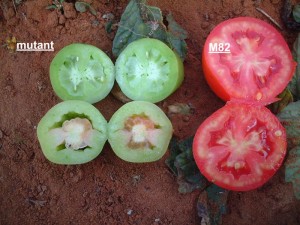
An anonymous indian tomato vendor in Chennai, Tamal Nadu. photo mckaysavage, flickr (click to see photo in it's original context)
First, since I didn’t explicitly state it in my previous post, the paper on the longer lasting tomatoes developed by India’s National Institute for Plant Genome Research didn’t report any data on how the RNAi knock-down tomatoes actually taste.* The tomatoes are nearly twice as firm as tomatoes in which these genes are NOT knocked down, so it’s possible they’d seem unpleasantly crunchy, I don’t know how doubling the firmness of a tomato translates into the feeling when a person bites into one.
On the other hand, if the tomatoes do turn out to be tasty and delicious, it’s quite possible the trait could be replicated without genetic engineering. And if that turns out to be true, it’s absolutely the approach anyone developing longer lasting farmers to Indian farmers, or farmers anywhere, should take (for why I’m saying this, check out the bit in bold further into this post). The synthetic microRNAs used in their experiments reduced gene expression by at least 99%, so, if it turns out that remained <1% isn’t playing a key role, the researchers at NIPGR have effectively created knock out lines for each of the two genes they were studying. Knocked out genes (genes so broken they don’t work anymore) has been a key part of genetics since before the word gene even existed. (Mendel in the 1850s and 1860s and Wilhelm Johannsen in 1905 respectively) With a couple of known targets, and a target phenotype that’s known to be worth the effort, creating tomatoes with “naturally” broken copies of the gene is possible and probably worth the effort to avoid the expense and controversy associated with trying to commercialize a new genetically engineered trait.

The mutant (left) and wildtype (right) tomatoes from mutant line e2615m1 from the mutant population cited below. Photo from the searchable database of identified mutant phenotypes at: http://zamir.sgn.cornell.edu/mutants/
Back in 2004 a paper** from two research groups in Israel described a saturation mutagenesis population*** of tomatoes created using EMS**** and fast neutron***** techniques. Screening 13,000 inbred lines for knock outs of either of these two genes would take a fair bit of time and money, but less than is involved trying to get approval of a genetically engineered trait (especially in India, where a political battle over their first genetically engineered food crop, an insect resistant breed of eggplant is still ongoing).
If it weren’t for (what I consider to be) irrational fears about genetic engineering and actions of people who exploit those fears, the arguments of speed and cost would instead rest with the genetically engineered RNAi knock downs already created in this study. Given the world we live in, and given there is an way to get the same benefits without genetic engineering in this particular case, getting the benefits of cheaper produce to people who could use the vitamins, and higher effective yields to farmers who could use the money must take priority. In the mean time people like you and I will just have to keep doing our best to combat that ignorance and fear so someday the deciding factor will be whatever technique is safest, fastest, and makes the most efficient use of scarce resources, not what people have, apparently arbitrarily, decided to natural or unnatural.
And as I said above, we don’t even know if the tomatoes are tasty, or if the NIPGR is or will be working on creating varieties of tomatoes with this trait for use by India’s farmers in the first place, so speculation on this paper may have gotten a bit too far ahead of itself.
*If they people who worked on the project are at all after my own heart, I’m sure they’ve tried the tomatoes for themselves, but subjective judgements like taste aren’t going to make it into a PNAS paper on fruit ripening (and its possible consuming genetically engineered tomatoes that haven’t been approved would technically be breaking the law in India, in which case the researchers would even less inclined to publicize any off the books tasting they did on their own.)
**Menda, N et al “In Silico Screening of a Saturated Mutation Library of Tomato” The Plant Journal DOI: 10.1111/j.1365-313X.2004.02088.x
***A mutagenesis population is a group of plant lines that have all been exposed so some mutating agent (see the footnotes on EMS and fast neutron). A saturation mutagenesis population is one where, based on the number of lines of plants in the population and an estimate of the number of mutated genes in each line, a mutation of (almost) any gene in the genome will likely be found somewhere in the population. The exception being really genes that are so bad to lose that plants carry even one broken copy, or gene and pollen cells (which only have one copy to begin with), die without being able to reproduce.
****EMS stands for Ethyl methanesulfonate, a chemical that creates a specific kind of mutation in the genome of a plant (changing some Gs into Ts). Exposing plants to specific doses of this chemical creates (on average) predictable numbers of mutations in the genome.
*****Fast neutron mutagenesis is less common than EMS, likely because creating fast neutrons involves the use of radioactive substances (one source I found specifically cited uranium aluminum alloys). The advantage of fast neutron mutagenesis is that as the neutrons tear through cells they tend to rip away large chunks of DNA (hundreds or thousands of As, Cs, Ts, and Gs at once) which makes the resulting mutants more likely to completely lose the function of a gene (imagine using EMS to create mutations as changing a couple of key letters in a recipe, and using fast neutrons as tearing out a whole page of a cook book and throwing it away).
I bet they tasted them too! I was thinking about emailing the 1st author to see 🙂
Comment by Anastasia — February 10, 2010 @ 11:13 am
If you do, that’s something I’d really enjoy hearing about. (I know I couldn’t work up the outgoing-ness (for lack of a better word) to ask myself though.)
Comment by James — February 10, 2010 @ 11:49 am